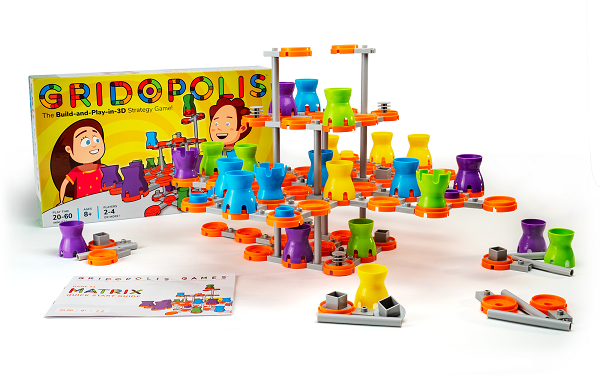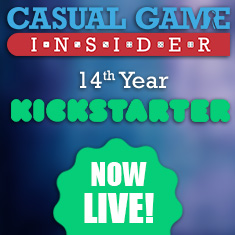Gridopolis Game System: A Build Your Own Strategy Game

Snap the pieces together and build the multi-level game board. But it’s not just the board that is customizable!
Gridopolis aims to be a game system, allowing you to play multiple different game types with the same set of components. So how does it work?
Gameplay
Gridopolis comes with several different types of pieces: pads, links, and posts. Links are used to connect pads to each other and both ends of a post can be inserted into two links to allow you to start building a second, or even third or fourth level to the board.
Players put together the 3D board they are going to play on. The game comes with several suggestions but you can also invent your own layout. Essentially, Gridopolis is a game system, with the makers encouraging you to come up with your own rulesets; however the box does come with a pre-built ruleset as well.
In this ruleset, after building the board, each player takes a set of two posts, two blocker boxes (when placing one of these on a pad no one can move their piece onto it for the rest of the game) and three pads. Each player has six gaming pieces, and three ‘kingerizer’ tokens which they place at their end of the board. Your gaming pieces start out as pawns.
On your turn you may move any one of your pawns one pad over in any direction other than backwards. This can be forward, sideways, diagonally, up a level, or down a level. You may also jump over one of your own pieces. If you jump over an opponent’s piece, it is captured. You must jump over an opponent's piece in a straight line, and when jumping over pieces this can include jumping from one level to the next. For example if your piece is on the third level and an opponent’s piece is on the second, you may jump ‘over’ them to the bottom level, capturing their piece. When a piece is captured, it is removed from the board. If jumping over a piece causes your piece to jump off the board, the piece is captured but your piece is as well. Also, on certain pads you place hyper-pads; when your piece lands on one of these, it teleports to any other hyper-pad of your choice that is not currently occupied.
If your pawn reaches an opponent’s kingerizer token, you flip the pawn over. It is now a king and may move in any direction including backwards. When moving a king, you also get to move it twice.
Alternatively on your turn, rather than moving a piece, you may place one of your blockers or add one of your pads to the game board.
There are two modes in which you can play this ruleset. In the first you play for a set time, at the end of which you earn points for each pawn or king you have captured and that you have remaining on the board. In the other mode, you simply keep playing until only one player has any pieces left on the board.

Review
Gridopolis is fascinating in a lot of ways. The 3D board element is immediately appealing and the open-ended nature of the rules and the game system aspect is intriguing and it will be interesting to see what games people come up with for it. It would be nice if more optional game modes were included straight out of the box, but the one that is there is still fun and nicely showcases what the game pieces can do.
There are elements of classics such as Chess and Checkers in the game mode but it is still different enough to stand on its own. The ability to add to the board offers you unique ways to manipulate your pieces and their movement, and the multi-level nature of the board mixes things up as do the hyper-pads. Keeping track of all three levels of the board can be challenging, and there can be a bit of a learning curve in visualizing legal captures between levels, but it’s worth the effort.
The game does take some time to set up and take down as you create the board, but while take down is a bit of a chore, snapping the pieces together to build it is actually enjoyable. The pieces join together nicely and the result is a lot sturdier than you might at first expect. While playing, we ran into no issues with the board.
Gridopolis does seem to be marketing itself to children, with its cover art and website, though the gameplay is fun for adults as well and the ability to craft your own rules seems slightly more focused for an older audience.
With the wide range of board layouts, there is a great deal of replay value. If you enjoy testing your creative abilities, Gridopolis offers plenty of opportunities and hopefully more game modes will become available on the publisher’s website over time.
Pros: Ability to play multiple game types, customizable board, component quality
Cons: Set up and take down is extensive, limited rulesets available at this time
UPDATE 3/13/2019: The publisher has begun to release new game modes, called "Gridset Blueprints". The first one, Twisted Tower, was published recently and more are in the works.
Disclosure: we received a complimentary review copy of this game.









